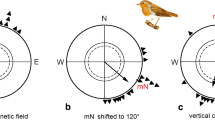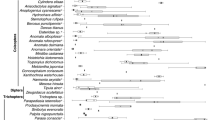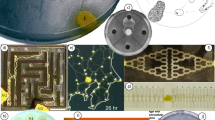Abstract
Like many vertebrate species, insects rely on a sun compass for spatial orientation and long- range navigation. In addition to the sun, however, insects can also use the polarization pattern of the sky as a reference for estimating navigational directions. Recent analysis of polarization vision pathways in the brain of orthopteroid insects sheds some light onto brain areas that might act as internal navigation centers. Here I review the significance, peripheral mechanisms, and central processing stages for polarization vision in insects with special reference to the locust Schistocerca gregaria. As in other insect species, polarization vision in locusts relies on specialized photoreceptor cells in a small dorsal rim area of the compound eye. Stages in the brain involved in polarized light signaling include specific areas in the lamina, medulla and lobula of the optic lobe and, in the midbrain, the anterior optic tubercle, the lateral accessory lobe, and the central complex. Integration of polarized-light signals with information on solar position appears to start in the optic lobe. In the central complex, polarization-opponent interneurons form a network of interconnected neurons. The organization of the central complex, its connections to thoracic motor centers, and its involvement in the spatial control of locomotion strongly suggest that it serves as a spatial organizer within the insect brain, including the functions of compass orientation and path integration. Time compensation in compass orientation is possibly achieved through a neural pathway from the internal circadian clock in the accessory medulla to the protocerebral bridge of the central complex.





Similar content being viewed by others
References
Baker RR (1978) The evolutionary ecology of animal migration. Hodder and Stoughton, London
Baker PS, Gewecke M, Cooter RJ (1984) Flight orientation of swarming Locusta migratoria. Physiol Entomol 9:247–252
Bingman VP, Able KP (2002) Maps in birds: representational mechanisms and neural bases. Curr Opin Neurobiol 12:745–750
Blum M, Labhart T (2000) Photoreceptor visual fields, ommatidial array, and receptor axon projections in the polarisation-sensitive dorsal rim area of the cricket compound eye. J Comp Physiol A 186:119–128
Collett M, Collett TS (2000) How do insects use path integration for their navigation? Biol Cybern 83:245–259
Collett TS, Collett M (2002) Memory use in insect visual navigation. Nat Rev Neurosci 3:542–552
Eggers A, Gewecke M (1993) The dorsal rim area of the compound eye and polarization vision in the desert locust (Schistocerca gregaria). In: Wiese K, Gribakin FG, Popov AV, Renninger G (eds) Sensory systems of arthropods. Birkhäuser, Basel, pp 101–109
Eggers A, Weber T (1993) Behavioural evidence for polarization vision in locusts. In: Elsner N, Heisenberg M (eds) Gene–brain–behaviour. Thieme, Stuttgart, p 336
Esch HE, Burns JE (1996) Distance estimation by foraging honeybees. J Exp Biol 199:155–162
Farrow RA (1990) Flight and migration in acridoids. In Chapman RF, Joern A (eds) Biology of grasshoppers. Wiley, New York, pp 227–314
Frisch K von (1967) The dance language and orientation of bees. Harvard University Press, Cambridge, Mass.
Ghaffar H, Larsen JR, Booth GM, Perkes R (1984) General morphology of the brain of the blind cave beetle, Neaphaenops tellkampfii Erichson (Coleoptera: Carabidae). Int J Insect Morphol Embryol 13:357–371
Giurfa M, Capaldi E (1999) Vectors, routes and maps: new discoveries about navigation in insects. Trends Neurosci 22:237–242
Goldsmith TH, Wehner R (1977) Restrictions on rotational and translational diffusion of pigment in the membranes of a rhabdomeric photoreceptor. J Gen Physiol 70:453–490
Hanesch U, Fischbach KF, Heisenberg M (1989) Neuronal architecture of the central complex in Drosophila melanogaster. Cell Tissue Res 257:343–366
Hartmann G, Wehner R (1995) The ant’s path integration system: a neural architecture. Biol Cybern 73:483–497
Helfrich-Förster C, Stengl M, Homberg U (1998) Organization of the circadian system in insects. Chronobiol Int 15:567–594
Homberg U (1987) Structure and functions of the central complex in insects. In Gupta AP (ed) Arthropod brain: its evolution, development, structure, and functions. Wiley, New York, pp 347–367
Homberg U (1994a) Flight-correlated activity changes in neurons of the lateral accessory lobes in the brain of the locust Schistocerca gregaria. J Comp Physiol A 175:597–610
Homberg U (1994b) Distribution of neurotransmitters in the insect brain. (Progress in Zoology 40) Fischer, Stuttgart
Homberg U, Hildebrand JG (1994) Postembryonic development of γ-aminobutyric acid-like immunoreactivity in the brain of the sphinx moth Manduca sexta. J Comp Neurol 339:132–149
Homberg U, Paech A (2002) Ultrastructure and orientation of ommatidia in the dorsal rim area of the locust compound eye. Arthropod Struct Dev 30:271–280
Homberg U, Würden S (1997) Movement-sensitive, polarization-sensitive, and light-sensitive neurons of the medulla and accessory medulla of the locust, Schistocerca gregaria. J Comp Neurol 386:329–346
Homberg U, Würden S, Dircksen H, Rao KR (1991) Comparative anatomy of pigment-dispersing hormone-immunoreactive neurons in the brain of orthopteroid insects. Cell Tissue Res 266:343–357
Homberg U, Hofer S, Pfeiffer K, Gebhardt S (2003a) Organization and neural connections of the anterior optic tubercle in the brain of the locust, Schistocerca gregaria. J Comp Neurol 462:415–430
Homberg U, Reischig T, Stengl M (2003b) Neural organization of the circadian system of the cockroach Leucophaea maderae. Chronobiol Int 20:577–591
Horváth G, Varjú D (2003) Polarization patterns in nature and polarized light in animal vision. Springer, Berlin Heidelberg New York
Israelachvili JN, Wilson M (1976) Absorption characteristics of oriented photopigments in microvilli. Biol Cybern 21:9–15
Kanzaki R (1998) Coordination of wing motion and walking suggests common control of zigzag motor program in a male silkworm moth. J Comp Physiol A 182:267–276
Kennedy JS (1945) Observations on the mass migration of desert locust hoppers. Trans R Entomol Soc Lond 95:247–262
Kennedy JS (1951) The migration of the desert locust (Schistocerca gregaria FORSK.). I. The behaviour of swarms. II. A theory of long-range migrations. Philos Trans R Soc Ser B 235:163–290
Labhart T (1988) Polarization-opponent interneurones in the insect visual system. Nature 331:435–437
Labhart T (1996) How polarization-sensitive interneurones of crickets perform at low degrees of polarization. J Exp Biol 199:1467–1475
Labhart T (2000) Polarization-sensitive interneurons in the optic lobe of the desert ant Cataglyphis bicolor. Naturwissenschaften 87:133–136
Labhart T, Meyer EP (1999) Detectors for polarized skylight in insects: a survey of ommatidial specializations in the dorsal rim area of the compound eye. Microsc Res Tech 47:368–379
Labhart T, Meyer EP (2002) Neural mechanisms in insect navigation: polarization compass and odometer. Curr Opin Neurobiol 12:707–714
Labhart T, Petzold J (1993) Processing of polarized light information in the visual system of crickets. In Wiese K, Gribakin F, Popov AV, Renninger G (eds) Sensory system of arthropods. Birkhäuser, Basel, pp 158–168
Labhart T, Petzold J, Helbling H (2001) Spatial integration in polarization-sensitive interneurones of crickets: a survey of evidence, mechanisms and benefits. J Exp Biol 204:2423–2430
Lambrinos D (2003) Navigation in desert ants: the robotic solution. Robotica 21:407–426
Lindauer M (1954) Dauertänze im Bienenstock und ihre Beziehung zur Sonnenbahn. Naturwissenschaften 41:506–507
Lindauer M (1960) Time-compensated sun orientation in bees. Cold Spring Harbor Symp Quant Biol 25:371–377
Loesel R, Homberg U (2001) Anatomy and physiology of neurons with processes in the accessory medulla of the cockroach Leucophaea maderae. J Comp Neurol 439:193–207
Mappes M, Homberg U (2004) Behavioral analysis of polarization vision in tethered flying locusts. J Comp Physiol A 190:61–68
Meinertzhagen IA, Sorra KE (2001) Synaptic organization in the fly’s optic lamina: few cells, many synapses and divergent microcircuits. In: Kolb H, Robbs H, Wu S (eds) Progress in brain research, vol 131. Elsevier, New York, pp 53–69
Mishima T, Kanzaki R (1998) Coordination of flipflopping neural signals and head turning during pheromone-mediated walking in a male silkworm moth Bombyx mori. J Comp Physiol A 183:273–282
Mishima T, Kanzaki R (1999) Physiological and morphological characterization of olfactory descending interneurons of the male silkworm moth, Bombyx mori. J Comp Physiol A 184:143–160
Mouritsen H (2001) Navigation in birds and other animals. Image Vis Comput 19:713–731
Mouritsen H, Frost, BJ (2002) Virtual migration in tethered flying monarch butterflies reveals their orientation mechanisms. Proc Natl Acad Sci USA 99:10162–10166
Müller M, Homberg U, Kühn A (1997) Neuroarchitecture of the lower division of the central body in the brain of the locust (Schistocerca gregaria). Cell Tissue Res 288:159–176
Nilsson D, Labhart T, Meyer EP (1987) Photoreceptor design and optical properties affecting polarization sensitivity in ants and crickets. J Comp Physiol A 161:645–658
Panov AA (1959) Structure of the insect brain at successive stages of postembryonic development. II. The central body. Entomol Rev URSS 38:276–284
Papi F (1992) Animal homing. Chapman and Hall, London
Petzold J (2001) Polarisationsempfindliche Neuronen im Sehsystem der Feldgrille, Gryllus campestris: Elektrophysiologie, Anatomie und Modellrechnungen. PhD thesis, University of Zurich
Pfeiffer K, Homberg U (2003) Neurons of the anterior optic tubercle of the locust Schistocerca gregaria are sensitive to the plane of polarized light. In Elsner N, Zimmermann N (eds) The neurosciences from basic research to therapy. Thieme, Stuttgart, pp 567–568
Riley JR, Reynolds DR (1986) Orientation at night by high-flying insects. In Danthanarayana W (ed) Insect flight: dispersal and migration. Springer, Berlin Heidelberg New York, pp 71–87
Riley JR, Greggers U, Smith AD, Stach S, Reynolds DR, Stollhoff N, Brandt R, Schaupp F, Menzel R (2003) The automatic pilot of honeybees. Proc R Soc Lond B 270:2421–2424
Rossel S, Wehner R (1987) The bee’s e-vector compass. In Menzel R, Mercer A (eds) Neurobiology and behaviour of honeybees. Springer, Berlin Heidelberg New York, pp 76–93
Schaefer GW (1976) Radar observations of insect flight. In Rainey RC (ed) Insect flight. (Symposium of the Royal Entomological Society vol 7) Blackwell, Oxford, pp 157–197
Sharp PE, Blair HT, Cho J (2001) The anatomical and computational basis of the rat head-direction cell signal. Trends Neurosci 24:289–294
Srinivasan VM, Zhang SW, Altwen M, Tautz J (2000) Honeybee navigation: nature and calibration of the odometer. Science 287:851–853
Strausfeld NJ (1999) A brain region in insects that supervises walking. In Binder MD (ed) Progress in brain research, vol 123. Elsevier, Amsterdam, pp. 273–284
Strausfeld NJ, Blest AD (1970) Golgi studies on insects. Part I. The optic lobes of Lepidoptera. Philos Trans R Soc Lond Ser B 258:81–134
Strausfeld NJ, Nässel DR (1981) Neuroarchitectures serving compound eyes of Crustacea and insects. In: Autrum H (ed) Handbook of sensory physiology, vol VII/6B. Springer, Berlin Heidelberg New York, pp 1–132
Strauss R (2002) The central complex and the genetic dissection of locomotor behaviour. Curr Opin Neurobiol 12:633–638
Strauss R, Heisenberg M (1993) A higher control center of locomotor behavior in the Drosophila brain. J Neurosci 13:1852–1861
Taube JS (1998) Head direction cells and the neurophysiological basis for a sense of direction. Prog Neurobiol 55:225–256
Tinbergen N (1932) Über die Orientierung des Bienenwolfes (Philanthus triangulum Fabr.). Z Vgl Physiol 16:305–334
Uvarov BP (1966) Grasshoppers and locusts, vol 1. Cambridge University Press, New York
Vitzthum H, Homberg U (1998) Locustatachykinin I/II-immunoreactive neurons in the central complex of the locust brain. J Comp Neurol 390:455–469
Vitzthum H, Homberg U, Agricola H (1996) Distribution of Dip-allatostatin I-like immunoreactivity in the brain of the locust Schistocerca gregaria with detailed analysis of immunostaining in the central complex. J Comp Neurol 369:419–437
Vitzthum H, Müller M, Homberg U (2002) Neurons of the central complex of the locust Schistocerca gregaria are sensitive to polarized light. J Neurosci 22:1114–1125
Wang RF, Spelke ES (2002) Human spatial representation: insights from animals. Trends Cogn Sci 6:1114–1125
Waterman TH (1989) Animal navigation. Freeman, New York
Wehner R (1984) Astronavigation in insects. Annu Rev Entomol 29:277–298
Wehner R (1992) Arthropods. In: Papi F (ed) Animal homing. Chapman and Hall, London, pp 45–144
Wehner R (1994) The polarization-vision project: championing organismic biology. In: Schildberger K, Elsner N (eds) Neural basis of behavioural adaptations. Fischer, Stuttgart, pp 103–143
Wehner R (1997) The ant’s celestial compass system: spectral and polarization channels. In: Lehrer M (ed) Orientation and communication in arthropods. Birkhäuser, Basel, pp 145–185
Wehner R (2001) Polarization vision: a uniform sensory capacity? J Exp Biol 204:2589–2596
Wehner R (2003) Desert ant navigation: how miniature brains solve complex tasks. J Comp Physiol A 189:579–588
Wehner R, Bernhard GD (1993) Photoreceptor twist: a solution to the false color problem. Proc Natl Acad Sci USA 90:4132–4135
Wehner R, Michel B, Antonsen P (1996) Visual navigation in insects: coupling of egocentric and geocentric information. J Exp Biol 199:129–140
Williams JLD (1975) Anatomical studies of the insect central nervous system: a ground-plan of the midbrain and an introduction to the central complex in the locust, Schistocerca gregaria (Orthoptera). J Zool 76:67–86
Wittmann T, Schwegler H (1995) Path integration: a network model. Biol Cybern 73:569–575
Wohlgemuth S, Ronacher B, Wehner R (2002) Distance estimation in the third dimension in desert ants. J Comp Physiol A 188:273–281
Würden S, Homberg U (1995) Immunocytochemical mapping of serotonin and neuropeptides in the accessory medulla of the locust, Schistocerca gregaria. J Comp Neurol 362:305–319
Zufall F, Schmitt M, Menzel R (1989) Spectral and polarized light sensitivity of photoreceptors in the compound eye of the cricket (Gryllus bimaculatus). J Comp Physiol A 164:597–608
Acknowledgements
I am grateful to Dr. Monika Stengl for her helpful comments on the manuscript and to Sascha Gotthardt for providing Fig. 3E, F. The research described in this paper is supported by the Deutsche Forschungsgemeinschaft, currently HO 950/13-2 and HO 950/14-1.
Author information
Authors and Affiliations
Corresponding author
Rights and permissions
About this article
Cite this article
Homberg, U. In search of the sky compass in the insect brain. Naturwissenschaften 91, 199–208 (2004). https://doi.org/10.1007/s00114-004-0525-9
Published:
Issue Date:
DOI: https://doi.org/10.1007/s00114-004-0525-9




